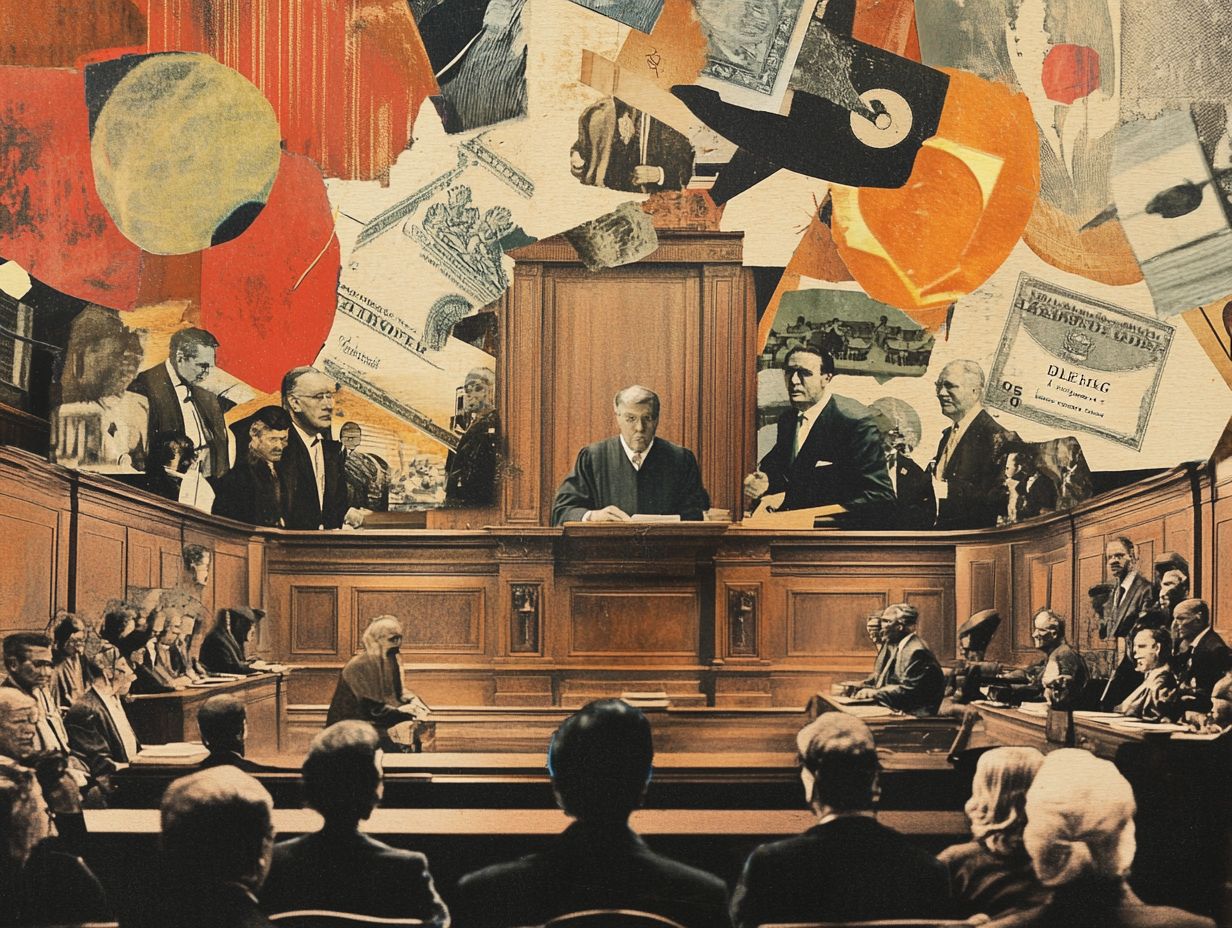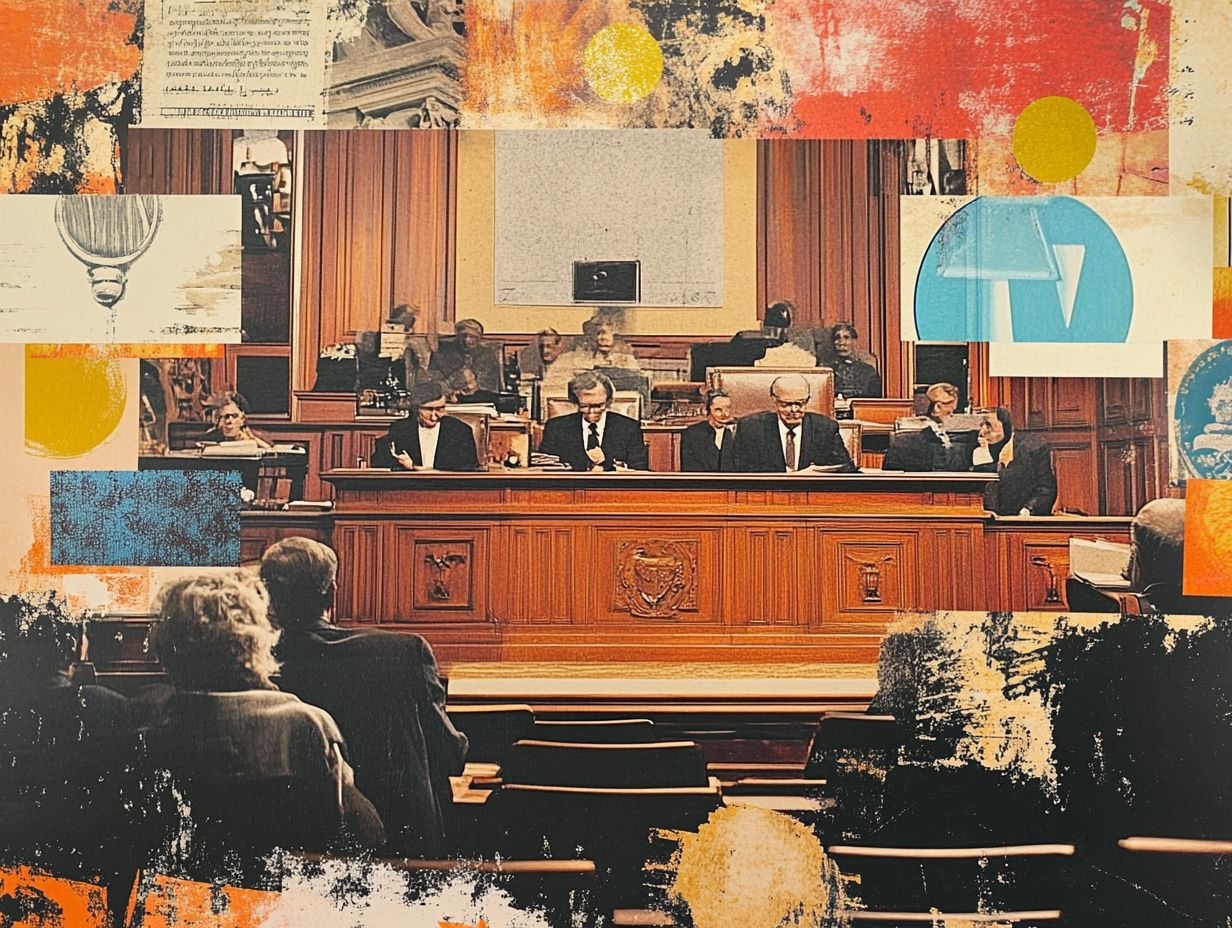5 Famous Trademark Cases That Changed the Law
Trademark disputes have the power to shape entire industries, influencing how you brand your business and interact with your customers.
This article delves into five landmark cases:
- Coca-Cola vs. Koke Co.
- McDonald’s vs. McDonald’s Family Restaurants
- Apple vs. Samsung
- Victoria’s Secret vs. Victor’s Little Secret
- Harley-Davidson vs. Grottanelli
Each case reveals the intricacies of trademark law and highlights its vital role in protecting brand identity.
You ll discover the purpose of trademark law, the key elements involved in a case, and how businesses can effectively safeguard their trademarks. Dive into these exciting moments in trademark history.
Contents
- Key Takeaways:
- The Coca-Cola Company v. Koke Co. of America
- McDonald’s Corporation v. McDonald’s Family Restaurants
- Apple, Inc. v. Samsung Electronics Co.
- Victoria’s Secret v. Victor’s Little Secret
- Harley-Davidson Motor Company v. Grottanelli
- What Is the Purpose of Trademark Law?
- Frequently Asked Questions
- What is a trademark and why is it important?
- What are some famous trademark cases that have had a significant impact on the law?
- How did the McDonald’s Corp. v. Joburgers Drive-Inn Restaurant, LTD case change the law?
- What was the impact of the Coca-Cola Co. v. The Koke Co. of America case?
- How did the Kellogg Co. v. National Biscuit Co. case change the way trademarks are protected?
- What can businesses learn from these famous trademark cases?
Key Takeaways:

Trademark law serves to protect a business’s brand and identity. Key elements of a trademark case include the distinctiveness and likelihood of confusion of the marks. Infringing on a trademark can result in legal consequences such as damages and injunctions.
The Coca-Cola Company v. Koke Co. of America
The landmark case of The Coca-Cola Company v. Koke Co. of America highlights the critical importance of trademark protection. It showcases how Coca-Cola valiantly defended its iconic brand against Koke Co.’s attempts to market a similar beverage, leading to significant legal implications for businesses regarding trademark infringement and consumer confusion.
This legal battle unfolded during a time when the beverage industry was rapidly evolving, making a distinct brand identity a crucial asset for companies like yours. Coca-Cola, with its internationally recognized trademark known for its refreshing taste and unique branding, argued passionately that the similarities between its product and Koke Co.’s soda could confuse consumers and dilute the brand s goodwill.
The court weighed arguments regarding the likelihood of confusion among customers, carefully considering evidence of actual market competition and consumer perception.
Ultimately, the ruling upheld Coca-Cola’s trademark rights and established a precedent, reinforcing the importance of protecting brand identity to ensure that consumers can reliably differentiate between products in a crowded marketplace.
This case serves as a vital reminder for you to safeguard your brand with vigilance and strategy.
McDonald’s Corporation v. McDonald’s Family Restaurants
The trademark dispute between McDonald’s Corporation and McDonald’s Family Restaurants illustrates the complex issues of brand ownership and trademark rights enforcement in the fast-food sector, as both parties endeavored to safeguard their unique identities and market presence.
The big company asserted that the smaller chain’s use of its iconic name could lead to significant consumer confusion, potentially undermining the brand equity cultivated over decades.
On the other hand, the family-owned establishment maintained that it had crafted its own distinct identity within a local framework. They believed they had every right to keep their name to foster customer loyalty.
The court sided with the larger chain, underscoring the significance of brand perception in a consumer-driven marketplace. This ruling reinforced the necessity of robust trademark protections and urged smaller businesses like yours to reconsider their naming strategies in an increasingly competitive landscape.
Apple, Inc. v. Samsung Electronics Co.
The legal battle between Apple and Samsung highlights their fierce competition in tech. The case vividly illustrates the intense rivalry within the technology sector.
Apple argued that Samsung’s Galaxy line of smartphones and tablets infringed upon its patented designs, particularly the iconic rectangular shape with rounded corners and the specific arrangement of icons on the home screen.
The evidence included detailed product comparisons and testimonials from designers that emphasized the innovative spirit behind Apple’s creations.
The court’s ruling significantly influenced both corporations and established a precedent that resonated throughout the tech industry. This prompted other companies to re-evaluate their design strategies.
This case shows the ongoing challenges in protecting intellectual property in a fast-evolving technological landscape. It reflects the continuous tug-of-war between creativity and legal boundaries.
Victoria’s Secret v. Victor’s Little Secret

The trademark dispute between Victoria’s Secret and Victor’s Little Secret is crucial for understanding how trademark law protects brand identity from consumer confusion. Victoria’s Secret aimed to safeguard its well-established brand image from a name that closely resembled its own.
Examining the origins of both brands reveals the diversity within the fashion retail market. Victoria’s Secret has long dominated the industry with its luxurious branding, while Victor’s Little Secret is a smaller, distinctive player.
Victoria’s Secret contended that the naming similarities could mislead consumers, infringing upon its trademark rights. The court’s ruling highlighted how vital consumer perception is in trademark cases, determining that the likelihood of confusion was significant.
This outcome not only reinforced the strength of established trademarks in fashion but also set a vital precedent for navigating brand names, as highlighted by notable figures in IP litigation history to avoid legal issues.
Harley-Davidson Motor Company v. Grottanelli
Harley-Davidson Motor Company’s conflict with Grottanelli underscores the importance of strong trademark enforcement in protecting iconic brand identities.
This case illustrates how the motorcycle giant fought to preserve its unique logo and the recognition it commands among consumers, while facing unauthorized use from a competitor.
The case revealed complexities surrounding the use of logos that closely resembled Harley-Davidson s established trademarks. The company argued that these similarities could mislead consumers and dilute its hard-earned brand equity.
The court’s decision reaffirmed the need to protect Harley-Davidson’s reputation and established a crucial legal precedent concerning trademark infringement in both the automotive and motorcycle industries.
The implications of this decision are extensive, urging manufacturers to be vigilant in safeguarding their intellectual property. This ruling is crucial for reinforcing brand loyalty and identity in an increasingly competitive market.
What Is the Purpose of Trademark Law?
Trademark law is an essential set of laws that protects your brand identity and ownership. It ensures that you can safeguard your unique trademarks and logos from infringement, which means using someone else’s trademark without permission. This prevents consumer confusion and fosters a competitive marketplace.
This legal structure not only defends your interests but also enhances consumer trust. It allows individuals to easily distinguish between competing products. When you secure your trademarks effectively, you lay the groundwork for strong branding strategies that resonate with your target audience.
Ultimately, this drives loyalty and expands your market share. The benefits of thorough trademark registration extend far beyond basic protection; they can significantly influence your marketing decisions and the overall growth trajectory of your company.
By understanding the complexities of trademark enforcement, you can navigate potential disputes more adeptly. This fortifies your position in the market while promoting innovation and healthy competition.
What Are the Key Elements of a Trademark Case?
A trademark case typically involves several key elements you ll need to navigate. These include evidence of trademark ownership, the likelihood of consumer confusion, and specific instances of alleged infringement that may arise between competing businesses.
Understanding the significance of trademarks as a source identifier is crucial. They enable consumers to distinguish between goods or services in an increasingly crowded marketplace.
To prove infringement, you ll need evidence that includes documentation of the trademark’s use in commerce. This could be sales figures, advertising samples, or customer testimonials that illustrate brand recognition.
When courts assess consumer confusion, they consider factors like the similarity of the trademarks and the proximity of the goods. They often use surveys to gauge public perception.
For example, imagine a case involving two similarly named beverage brands. This could easily lead to confusion in a retail setting, highlighting the importance of protecting intellectual property.
What Are the Potential Consequences of Infringing on a Trademark?

Infringing a registered trademark can lead to serious repercussions for your business. These may include legal actions, financial penalties, and long-lasting damage to your brand’s reputation and consumer trust.
When infringement occurs, you face a significant risk of substantial financial penalties. These can reach thousands or even millions, depending on the severity of the violation. The legal fees involved in defending against a trademark infringement lawsuit can quickly become a burden, diverting resources that could be better spent elsewhere.
The damage to your reputation can be significant. This could alienate loyal customers and instill distrust among potential clients.
Take, for example, the case of a well-known sportswear brand that faced considerable backlash and a drop in sales after being sued for producing counterfeit merchandise. This incident hurt their profits and damaged their reputation, demonstrating how the consequences of trademark infringement can extend far beyond financial losses.
How Can a Business Protect Their Trademark?
You can protect your trademarks through a strategic blend of registration, vigilant enforcement of your rights, and consistent branding efforts. This ensures that your unique identity remains safeguarded against potential infringements.
To navigate this process effectively, it’s crucial to conduct thorough research to confirm that your desired trademarks are available and not already in use. Once registration is complete, maintaining vigilance means regularly monitoring the marketplace to identify any unauthorized use of your trademarks.
Utilizing tools for market surveillance can be invaluable. These tools enable you to act swiftly when instances of infringement arise. Developing a comprehensive branding strategy that incorporates your trademark can significantly enhance recognition and loyalty among consumers.
If violations do occur, you might need to explore legal avenues. This includes sending cease-and-desist letters or pursuing litigation to uphold your trademark rights.
What Are Some Famous Trademark Disputes That Have Gone to Court?
Several high-profile trademark disputes have recently captured attention. These cases reveal the intricate world of intellectual property rights and the intense competition among major corporations. For a deeper dive, check out 5 notable trademarks and their histories to see the stakes involved with iconic brands like Apple, McDonald’s, and Harley-Davidson.
Take Apple s legendary showdown with Cisco over the iPhone trademark. This clash culminated in a settlement that allowed both companies to use the coveted name, showcasing the delicate balance of rights in the tech arena.
Then there s McDonald s, which found itself in a tug-of-war with a small restaurant chain over the term “Mac.” This case highlighted the importance of brand recognition and the potential for consumer confusion. Ultimately, it resulted in a favorable decision for the fast-food titan.
On another front, Harley-Davidson’s effort to protect its brand from a small leather goods manufacturer illustrated the necessity of vigilance in upholding trademark rights.
These cases underscore the legal complexities at play and impart a vital lesson: strong trademark protection demands unwavering attention and proactive enforcement, as highlighted in the 5 key takeaways from recent IP litigation cases.
How Have These Cases Shaped Trademark Law Today?
The multitude of trademark cases adjudicated in courts has profoundly shaped the current landscape of trademark law. To understand this better, it’s helpful to explore notable international IP cases, as these rulings influence how you approach branding, enforcement, and the legal frameworks that safeguard your identity.
These pivotal decisions have redefined the parameters of trademark rights, adapting to an ever-evolving marketplace. As legal interpretations shift, they highlight not just the details of trademark registration but also the vital role consumer perceptions play in establishing brand identity, much like the lessons learned from the top 5 famous trade secret cases.
Recent disputes have underscored the significance of distinctiveness and the likelihood of confusion (the potential for consumers to mistake one brand for another). This has led to stricter enforcement of intellectual property rights. You must now navigate a more complex legal landscape and adjust your strategies to align with contemporary consumer expectations and judicial standards.
This ensures that your trademarks remain not only protected but also relevant in today’s competitive environment.
Frequently Asked Questions

What is a trademark and why is it important?
A trademark is a word, phrase, symbol, or design that identifies and distinguishes the source of the goods or services of one party from those of others. It is important because it helps consumers identify and associate products or services with a particular brand or company. Additionally, it serves as a valuable asset for businesses in terms of reputation and market presence.
What are some famous trademark cases that have had a significant impact on the law?
There have been many trademark cases that have shaped current laws and regulations. Some of the most renowned include McDonald’s Corp. v. Joburgers Drive-Inn Restaurant, LTD; Coca-Cola Co. v. The Koke Co. of America; and Kellogg Co. v. National Biscuit Co. (the “Shredded Wheat” case), as detailed in 5 famous trademark litigation cases and their impact.
How did the McDonald’s Corp. v. Joburgers Drive-Inn Restaurant, LTD case change the law?
In this case, the court ruled that McDonald’s had the right to protect its trademark, even in countries where it had not established a presence. This ruling set a precedent for companies to protect their trademarks internationally, even if they had not yet entered a particular market.
What was the impact of the Coca-Cola Co. v. The Koke Co. of America case?
This case established the concept of “inherent distinctiveness.” This means that a trademark does not have to be descriptive to receive protection. The court ruled that Coca-Cola’s trademark was inherently distinctive and deserved protection, even though it was not a descriptive term.
How did the Kellogg Co. v. National Biscuit Co. case change the way trademarks are protected?
This case introduced the concept of “likelihood of confusion” when it comes to trademark infringement. The court ruled that National Biscuit Co.’s use of the term “Shredded Wheat” was likely to confuse consumers, and therefore constituted trademark infringement. This ruling set a precedent for future cases involving trademarks that are similar to existing ones.
Interested in learning more about trademarks? Reach out for legal advice or additional resources!
What can businesses learn from these famous trademark cases?
These cases show how crucial it is to protect trademarks, as illustrated by five uncommon copyright cases. Infringement can lead to serious consequences.
Businesses must register their trademarks. They should also monitor and enforce their rights to stop others from using similar marks that might confuse customers or weaken their brand. Don’t wait protect your brand today!






